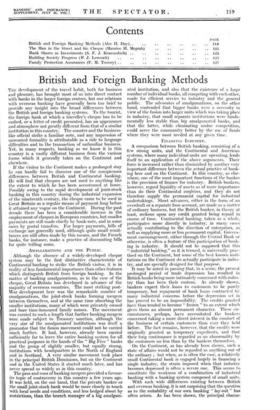British and Foreign Banking Methods THE development of the travel
habit, both for business and pleasure, has brought most of us into direct contact with banks in the larger foreign centres, but our relations with overseas banking have generally been too brief to provide any insight into the broad differences between the British and foreign banking systems. To the tourist, the foreign bank at which a traveller's cheque has to be cashed, or a letter of credit presented, has an appearance and atmosphere not greatly different from that of a similar institution in this country. The counter and the business- like official strike a familiar note, and any impression of unwonted formality is attributable as a rule to language difficulties and to the transaction of unfamiliar business. Yet, in many respects, banking as we know it in this country is a vastly different business from the various forms which it generally takes on the Continent and elsewhere.
If the visitor to the Continent makes a prolonged stay he can hardly fail to discover one of the conspicuous differences between British and Continental banking. He will find that cheques are not used to anything like the extent to which he has been accustomed at home. Possibly owing. to the rapid development of joint-stock banking in this country during the industrial expansion of the nineteenth century, the cheque came to be used in Great Britairras—a-regular means of payment long-before it attained any vogue on the Continent. During the past decade there has been a considerable increase in the employment of cheques in European countries, but smaller payments are still made chiefly by bank-note, and in some cases by postal transfers. Ifor larger payments, ,bills of exchange are generally used, although quite small remit- tances are still often made by this means, and the French banks, for instance, make a practice of discounting bills Or quite trifling sums.










































 Previous page
Previous page